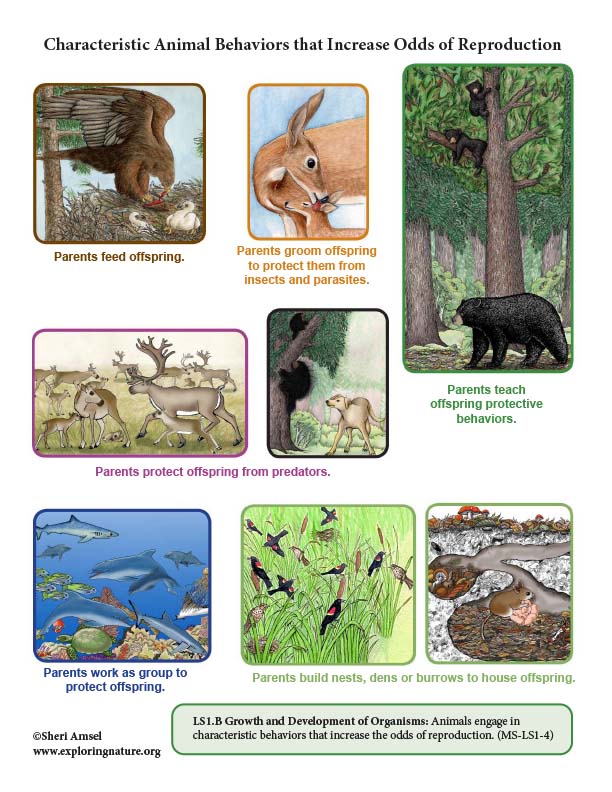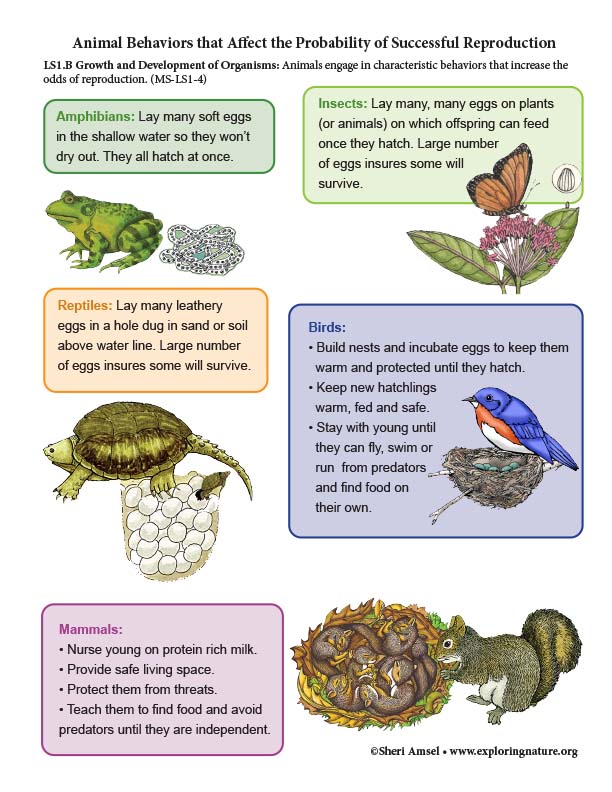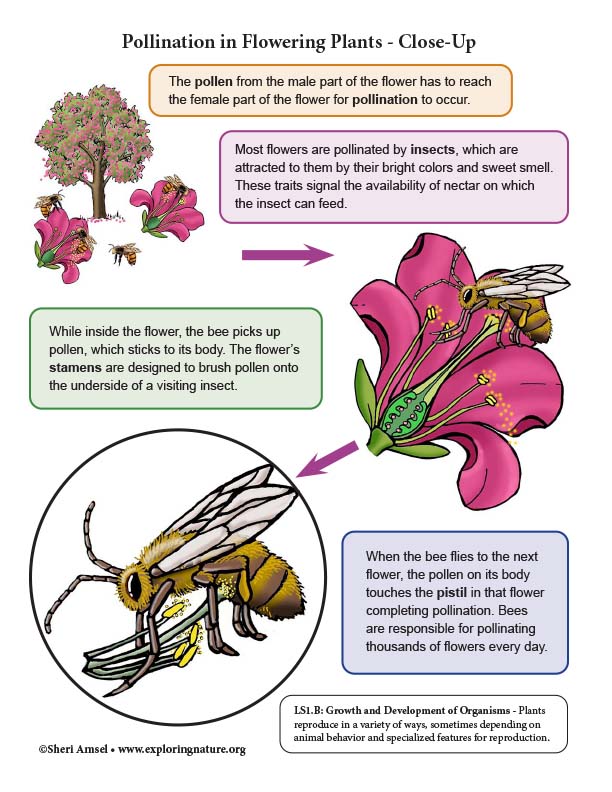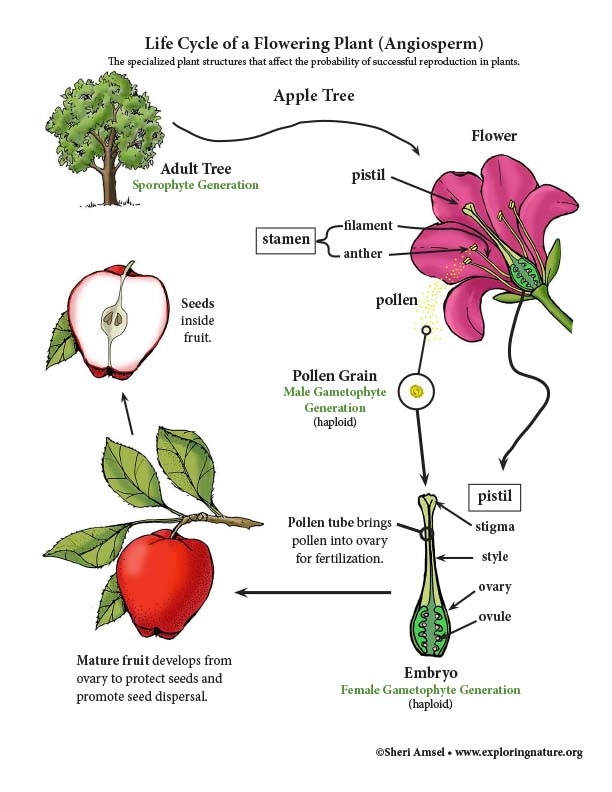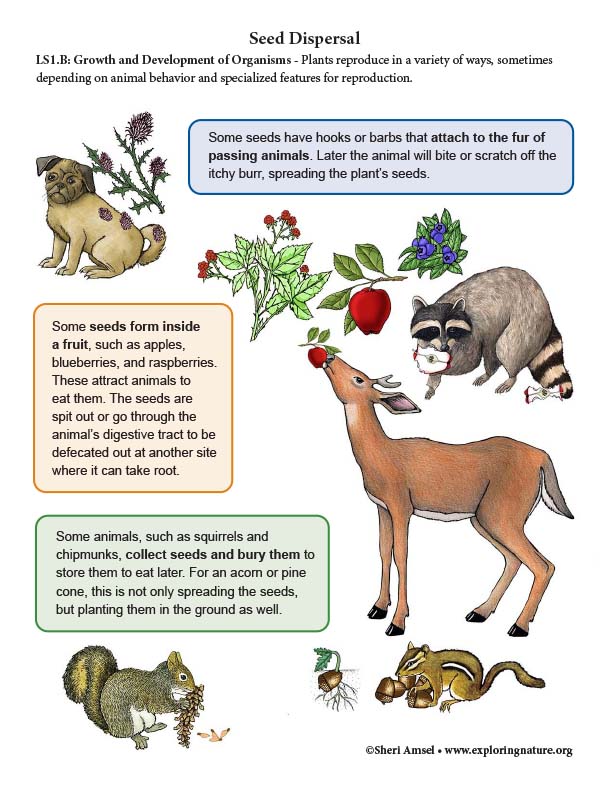

Disciplinary Core Ideas
LS1.B: Growth and Development of Organisms
• Animals engage in characteristic behaviors that increase the odds of reproduction. (MS-LS1-4)
• Plants reproduce in a variety of ways, sometimes depending on animal behavior and specialized features for reproduction. (MS-LS1-4)
• Genetic factors as well as local conditions affect the growth of the adult plant. (MS-LS1-5)
Use the Template and Resource Links to Fulfill NGSS
l. Goals:
Essential Questions:
NGSS Note: Think, question, entertain ideas.
B. Brainstorming Sessions
Question: What are some ways animals and plants are adapted for successful reproduction?
1. Break students down into groups of 3-4.
2. Ask students to generate a list of the different ways animals or plants behave or are physically structured to help with successful reproduction (i.e. nest building, sticky seeds, etc.)
3. Discuss
lll. New Knowledge - Text
Read about plant and animal reproduction behaviors.
Plant Adaptations For Pollination And Seed Dispersal
Helping Baby Survive
Growth and Development of Organisms - Reproductive Behaviors
Nesting Behaviors that Affect the Probability of Successful Reproduction
Animal Behaviors that Affect the Probability of Successful Reproduction in Monarch Butterflies
Animal Behaviors that Affect the Probability of Successful Reproduction in Bullfrogs
Animal Behaviors that Affect the Probability of Successful Reproduction in Barn Swallows
Animal Behaviors that Affect the Probability of Successful Reproduction in Black Bears
Acid Rain - How Environmental Factors Influence the Growth of Organisms
Read about Genetic Factors and Local Conditions Affecting Growth of Plants.
Plant Reproduction Illustrated - Growth and Development of Organisms
The Rodent, the Bee, and the Brazil Nut Tree
Learn about how plants spread their seeds: Seed Dispersal - An Investigation
Explain what this comic means: Seed Dispersal Adaptation - Comic Relief Activity
V. Summarize Knowledge - Enduring Understandings
Vl. Next Generation of Science Standards (NGSS) - Middle School Life Science
Disciplinary Core Ideas
LS1.C: Organization for Matter and Energy Flow in Organisms
• Plants, algae (including phytoplankton), and many microorganisms use the energy from light to make sugars (food) from carbon dioxide from the atmosphere and water through the process of photosynthesis, which also releases oxygen. These sugars can be used immediately or stored for growth or later use. (MS-LS1-6)
• Within individual organisms, food moves through a series of chemical reactions in which it is broken down and rearranged to form new molecules, to support growth, or to release energy. (MS-LS1-7)
Science and Engineering Practices
Engaging in Argument from Evidence
Engaging in argument from evidence in 6–8 builds on K–5 experiences and progresses to constructing a convincing argument that supports or refutes claims for either explanations or solutions about the natural and designed world(s).
• Use an oral and written argument supported by evidence to support or refute an explanation or a model for a phenomenon. (MS-LS1-3)
• Use an oral and written argument supported by empirical evidence and scientific reasoning to support or refute an explanation or a model for a phenomenon or a solution to a problem. (MS-LS1-4)
Crosscutting Concepts
Cause and Effect
• Cause and effect relationships may be used to predict phenomena in natural systems. (MS-LS1-8)
• Phenomena may have more than one cause, and some cause and effect relationships in systems can only be described using probability. (MS-LS1-4),(MS-LS1-5)
Performance Expectations
Students who demonstrate understanding can:
MS-LS1-4. Use argument based on empirical evidence and scientific reasoning to support an explanation for how characteristic animal behaviors and specialized plant structures affect the probability of successful reproduction of animals and plants respectively. [Clarification Statement: Examples of behaviors that affect the probability of animal reproduction could include nest building to protect young from cold, herding of animals to protect young from predators, and vocalization of animals and colorful plumage to attract mates for breeding. Examples of animal behaviors that affect the probability of plant reproduction could include transferring pollen or seeds, and creating conditions for seed germination and growth. Examples of plant structures could include bright flowers attracting butterflies that transfer pollen, flower nectar and odors that attract insects that transfer pollen, and hard shells on nuts that squirrels bury.]
MS-LS1-5. Construct a scientific explanation based on evidence for how environmental and genetic factors influence the growth of organisms. [Clarification Statement: Examples of local environmental conditions could include availability of food, light, space, and water. Examples of genetic factors could include large breed cattle and species of grass affecting growth of organisms. Examples of evidence could include drought decreasing plant growth, fertilizer increasing plant growth, different varieties of plant seeds growing at different rates in different conditions, and fish growing larger in large ponds than they do in small ponds.] [Assessment Boundary: Assessment does not include genetic mechanisms, gene regulation, or biochemical processes.]
When you research information you must cite the reference. Citing for websites is different from citing from books, magazines and periodicals. The style of citing shown here is from the MLA Style Citations (Modern Language Association).
When citing a WEBSITE the general format is as follows.
Author Last Name, First Name(s). "Title: Subtitle of Part of Web Page, if appropriate." Title: Subtitle: Section of Page if appropriate. Sponsoring/Publishing Agency, If Given. Additional significant descriptive information. Date of Electronic Publication or other Date, such as Last Updated. Day Month Year of access < URL >.
Amsel, Sheri. "LS1.B: Growth and Development of Organisms (MS-LS1 From Molecules to Organisms: Structures and Processes)" Exploring Nature Educational Resource ©2005-2024. December 13, 2024
< http://exploringnature.org/db/view/Grade-6-8-MS-LS1-From-Molecules-to-Organisms-Structures-and-Processes-LS1B-Growth-and-Development-of-Organisms >

